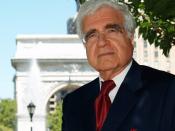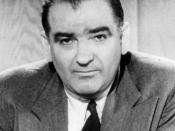There are many parallels that can be drawn between 'The Crucible' and Arthur Miller's own experiences of court. Around the time of publishing, there was a rise in 'McCarthyism' where Senator McCarthy had been appointed to hunt out America's new 'witches': communists. McCarthy sought not only confessions, but also the names of the alleged associates, if they did not name others, they would not be cleared of charges - much like in Salem 1692, where the 'witches' were saved only if they named others. The dramatic scenic unit in Act 4, which could be seen as a climax, of John Proctor confessing and then refusing to name others is very similar to when Arthur Miller was called before McCarthy in 1956 and refused to name others. However Miller maintains that he did not write 'The Crucible' intending to refer just to the McCarthyism but to all cases of mass hysteria and how people could and would turn on each other to save themselves, for example the persecution of Jews in Nazi Germany.
This can help the audience remember that 'the Crucible' is not just a fictional play, but is a very real story that could mirror many modern day cases of mass persecution, which helps creates a stronger dramatic impact on the audience as it is referring to the 'real world'.
Arthur Miller adapts the typical conventions of the structure of a four-act play in 'The Crucible'. Act 1 is traditionally the exposition, Act 2 the complication, Act 3 the climax with the crisis point, which is a turning point in the play, and Act 4 is the resolution, in which everything is solved. The climax is supposed to contain the moment of highest tension, a crisis. In fact Act 3 has several equally dramatic moments, blended into...


